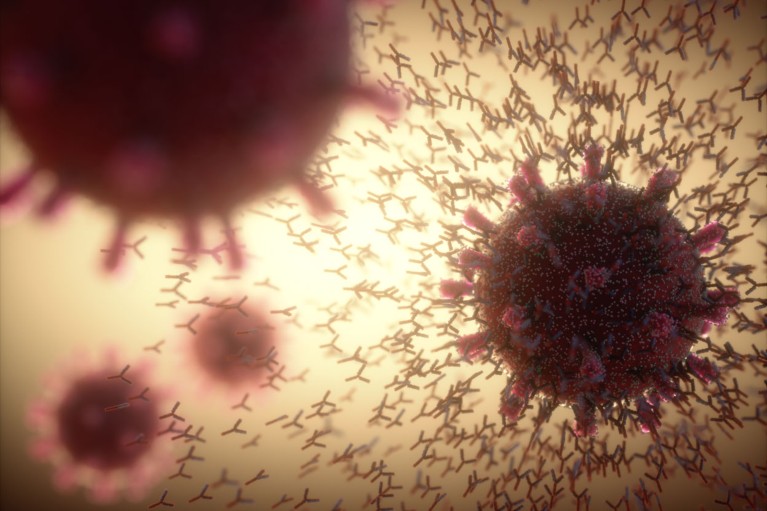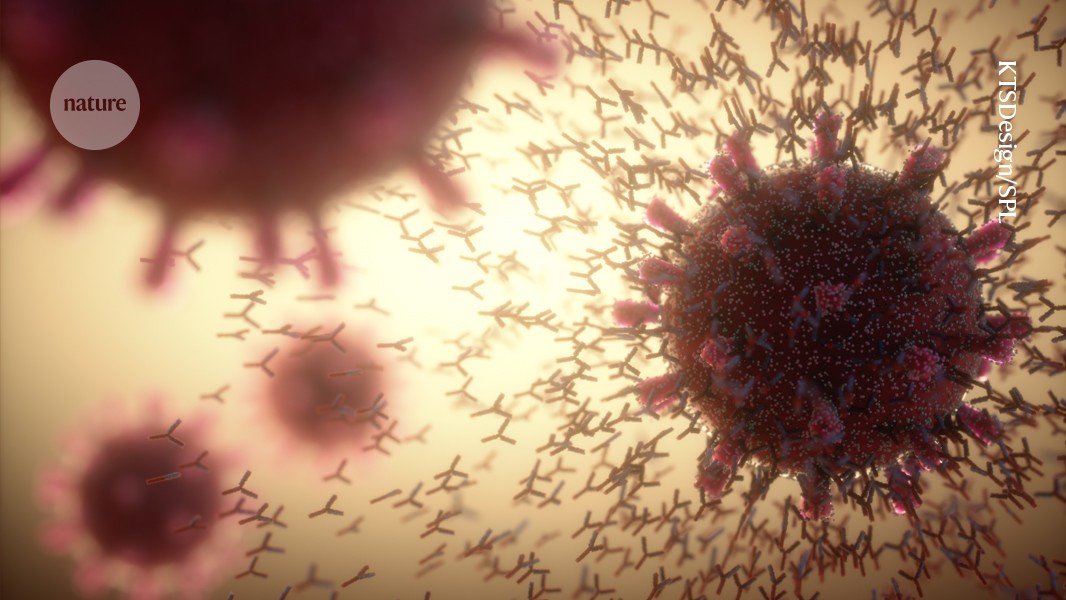
Artist’s illustration of antibodies (Y-shaped structures) flocking towards a SARS-CoV-2 particle (spiked sphere).Credit: KTSDesign/Science Photo Library
As COVID-19 began to surge five years ago, no one knew what to expect.
Neither did the immune system.
Confronted with a new virus, humanity was immunologically naive. The emergence of SARS-CoV-2 provided a rare opportunity to study the immune system in action, and researchers raced to gather all the data they could. “The world was exposed to a brand-new pathogen,” says Nadia Roan, an immunologist at the University of California, San Francisco. “We were trying to leverage that to learn more about immunity.”
Years later, scientists are still sifting through the data to garner a better understanding of how the immune system works. Here are four lessons they’ve learnt so far.
Antibodies aren’t everything
Early in the pandemic, many researchers focused on the antibodies produced in response to SARS-CoV-2 infection. Like antibodies, the immune components called T cells also combat infection — but these drew less attention at first. Many clinical trials of COVID-19 vaccines, for example, analysed antibody levels and not T cells.
That’s in part because T cells are more difficult to study than antibodies, and so our understanding of them has lagged, says Shane Crotty, an immunologist at the La Jolla Institute for Immunology in San Diego, California.
As the pandemic went on, however, it became clear that T cells were a crucial arm of the immune response to SARS-CoV-2 and to COVID-19 vaccines, says Alessandro Sette, also an immunologist at the La Jolla Institute for Immunology. Antibodies against SARS-CoV-2 waned in the months after vaccination, but vaccinated people continued to make T cells that recognized the virus1. That T-cell protection remained strong, Sette and others found2, even against viral variants that dodged the antibody defences raised by the first generation of COVID vaccines.
“People used to focus more on antibodies, and tended to forget about the T-cell responses,” says Rosemary Boyton, an immunologist at Imperial College London. “Now we understand much, much better that the T-cell responses matter as well.”
Early-warning immune alarm reaches the whole body
The pandemic also gave researchers new insights into the innate immune system, another line of defence against viruses.
Innate immune responses are not as specific as antibodies and T cells. Cells can unleash these responses when they detect foreign molecules, such as the RNA genome of SARS-CoV-2. When a cell discovers a telltale molecule, it raises the alarm, by releasing proteins called interferons. These proteins activate hundreds of genes, including many involved in viral defence. The interferon response also notifies other cells in the same organ to be on high alert, says Benjamin tenOever, a virologist at New York University in New York City. “It can be very damning to a virus.”
Kids and COVID: why young immune systems are still on top
Before the pandemic, researchers thought that this warning cry did not travel far beyond the site of infection. But when tenOever and his colleagues analysed samples from hamsters and from autopsies of people who had previously been infected with SARS-CoV-2, they found signs of interferon responses throughout the body, even in organs far away from infected cells3. Later, the team learnt that this is not limited to SARS-CoV-2: the flu virus also elicits a widespread interferon response in hamsters.
tenOever hypothesizes that these global anti-viral defences bolster protection in case the infection travels rapidly through the body. It might also be part of the reason that the SARS-CoV-2 variants that spread later in the pandemic were less likely than their predecessors to cause severe disease: the later variants bound better than earlier forms of the virus to cells in the nose, keeping the virus in the upper airways for longer. That allowed time for the innate warning signal to reach the lungs and bolster defences there before the virus arrived.
The nose knows
Before the pandemic, researchers weren’t terribly interested in the nose, says Jose Ordovas-Montanes, an immunologist at Boston Children’s Hospital in Massachusetts. “It was seen as just a passive tube to get air to the lungs,” he says. “And the lungs were where the business happened.”
The pandemic underscored the importance of understanding immune responses in specific tissues, and especially in the place where infection often starts: the nose.
The moist lining of the nose is a unique immune environment that contains a different blend of antibodies and immune cells to that found in the blood. As a result, injected vaccines, which generate antibodies in the bloodstream, might not be ideal for blocking infection in the nose. “One of the lessons from the pandemic is location, location, location,” says Crotty.



